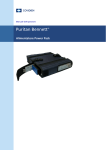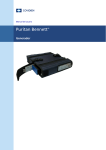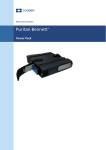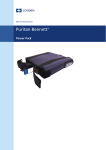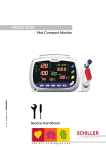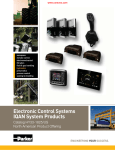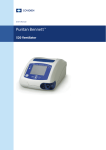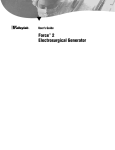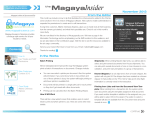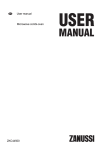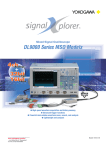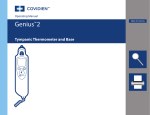Download Puritan Bennett
Transcript
User’s Manual Puritan Bennett Power Pack TM Copyright information COVIDIEN, COVIDIEN with logo, the Covidien logo and positive results for life are U.S. and/or internationally registered trademarks of Covidien AG. All other brands are trademarks of a Covidien company. © 2014 Covidien. The information contained in this manual is the sole property of Covidien and may not be duplicated without permission. This manual may be revised or replaced by Covidien at any time and without notice. You should ensure that you have the most current applicable version of this manual; if in doubt, contact Covidien's Technical Support department or visit the Puritan Bennett product manual web page at: http://www.respiratorysolutions.covidien.com While the information set forth herein is believed to be accurate, it is not a substitute for the exercise of professional judgment. The ventilator and battery pack should be operated and serviced only by trained professionals. Covidien’s sole responsibility with respect to the ventilator and battery pack, and its use, is as stated in the limited warranty provided. Nothing in this manual shall limit or restrict in any way Covidien’s right to revise or otherwise change or modify the equipment (including its software) described herein, without notice. In the absence of an express, written agreement to the contrary, Covidien has no obligation to furnish any such revisions, changes, or modifications (including its software) to the owner or user of the equipment described herein. Technical Support Contacts Covidien Argentina Estados Unidos 5180 (Complejo San Eduardo - Nave 4) CP:1667 Ciudad: Tortuguitas, Provincia: Buenos Aires, Argentina Tel: (5411) 4863-5300 Covidien Australia 52A Huntingwood Drive Huntingwood, NSW 2148 Australia Telephone (+61) 1800 350702 Covidien Austria GmbH Campus21 Europaring F09402 Brunn am Gebrige A-2345 Österreich Tel +43 223 637 88 39 Covidien Belgie S.A.-N.V. Generaal De Wittelaan 9/5 Mechelen 2800 België Tel +32 152 981 37 Covidien Brazil Av. Das Nações Undias 12995 Andar 23 - Brooklin São Paulo, SP Brasil 04578-000 Tel: (5511) 2187-6200 Covidien Canada 19600 Clark Graham Baie d'Urfe, QC, H9X 3R8 Canada Tel: 1-514-332-1220 Covidien Chile Rosario Norte 530, Piso 12 Las Condes Santiago de Chile, Chile Tel: (562) 231-3411 Covidien Colombia Edificio Prados de la Morea Carretera Central Del Norte (Cra 7a)Kilometro 18, Chia-Cundinamarca Bogota, Colombia Tel:(571)668-3777 Covidien Costa Rica De la Panasonic, 1 km al Sur y 400 m al Oeste, Ofibodegas del Oeste, Bodega #6 Lindora, San Jose, Costa Rica Tel: (506) 2239 - 4124 Covidien Czech Republic Covidien ECE s.r.o. Technical service Galvaniho 7/a 821 04 Bratsilava Slovakia Covidien Danmark A/S Tel +45 702 753 50 Arne Jacobsens Allé 7 5 sal DK-2300 COPENHAGEN S DENMARK (commercial only) Covidien Deutschland GmbH Technisches Service Center Raffineriestr. 18 93333 Neustadt / Donau Germany Tel +49 (0) 9445 959381 Covidien ECE Covidien ECE s.r.o. Technical service Galvaniho 7/a 821 04 Bratsilava Slovakia Tel+ Tel:4212 482 14573 Covidien Finland Oy Läkkisepäntie 23 00620 Helsinki Finland Tel. +35 896 226 84 10 Covidien France SA Parc d’affaires Technopolis Bat. Sigma, 3 Avenue du Canada LP 851 Les Ulis 91975 Courtaboeuf Cedex France Tel +33 169 821 400 Tel +33 (0) 810 787590 Covidien Hellas SA 8 Fragoklisias Street Maroussi, 151 25 Greece Tel +30 211 180 36 00 Covidien Hungary Covidien ECE s.r.o. Technical service Galvaniho 7/a 821 04 Bratsilava Slovakia Tel+ 421248214573 Covidien Ireland Commercial Ltd Block G, Ground Floor, Cherrywood Technology Park, Loughlinstown County Dublin Ireland Covidien Israel 5 Shacham St. North Industrial Park Caesarea 38900 Israel Tel +97 246 277 388 Covidien Italia S.p.A. Via Rivoltana 2/D 20090 Segrate Italy Tel +39 027 031 72 61 Covidien Japan Inc. Technical Support Center 83-1, Takashimadaira 1-Chome Itabashi-ku, Tokyo 175-0082 Japan Tel: +81 (0) 3 6859 0120 Covidien Mexico Insurgentes Sur No. 863 Piso 16 Col. Nápoles Del. Benito Juarez Mexico, D.F. 03810 Mexico Tel: (5255) 5804-1524 Covidien Nederland BV Hogeweg 105 5301 LL Zaltbommel Nederland Tel +31 41 857 66 68 Covidien Norge AS Postboks 343 1372 Asker. Norway Tel +47 668 522 22 Technical Support Contacts (Continued) Covidien Panama Parque Industrial Costa del Esta Calle Primera, Edifio # 109 Panama City, Panama Tel: (507) 264-7337 Covidien Polska COVIDIEN POLSKA SP.Z.O.O AL JEROZOLIMSKIE 181 WARSZAWA POLSKA 02-342 Tel:+48 2227 90405 Covidien Portugal Lda. Estrada do Outeiro de Polima, Lote 10-1° Abóboda 2785-521 S.Domingos de Rana Portugal Tel +35 121 448 10 36 Covidien Puerto Rico Palmas Industrial Park Road 869 Km 2.0 Bdlg. #1 Cataño, PR 00962 Tel. 787-993-7250 Ext. 7222 & 7221 Covidien Russia 53 bld. 5 Dubininskaya Street Moscow RUSSIA. 119054Tel +70 495 933 64 69 Covidien Saglik A.S. Maslak Mahallesi Bilim Sokak No: 5, Sun Plaza Kat: 2-3 Sisli, Istanbul 34398 Turkey [T] (+90) 212 366 20 00 [F] (+90) 212 276 35 25 Covidien South Africa Corporate Park North 379 Roan Crescent Randjespark Midrand, South Africa Tel +27 115 429 500 Covidien Spain S.L. COVIDIEN SPAIN, S.L WORLD TRADE CENTER ALMEDA PARK PLAÇA DE LA PAU, S/N, EDIF 7-3ª PLANTA 08940 CORNELLA DE LLOBREGAT BARCELONA 8970 Tel 00 34 9347 58669 Covidien Sverige AB Box 54 171 74 Solna Sweden Tel +46 858 56 05 00 Covidien Switzerland Roosstr. 53 Wollerau 8832 Schweiz Tel +41 17865050 Covidien UK & Ireland Unit 2, Talisman Business Park London Road, Bicester OX26 6HR, United Kingdom Tel +44(0)1869 328092 Asia: Covidien Private Limited Singapore Regional Service Centre 15 Pioneer Hub, #06-04 Singapore 627753 Tel (65) 6578 5187 / 8 / 9 Tel (65) 6515 6578/5288 Email: [email protected] Covidien USA 2101 Faraday Ave Carlsbad, CA 92008 Phone: 1-800-255-6774 (option 4) Email: [email protected] Table of Contents 1 Safety Information 1.1 Overview . . . . . . . . . . . . . . . . . . . . . . . . . . . . . . . . . . . . . . . . . . . . . 1.2 Definitions . . . . . . . . . . . . . . . . . . . . . . . . . . . . . . . . . . . . . . . . . . . . 1.3 Warnings. . . . . . . . . . . . . . . . . . . . . . . . . . . . . . . . . . . . . . . . . . . . . 1.4 Symbols, Labels and Markings . . . . . . . . . . . . . . . . . . . . . . . . . . . . . 1 1 1 4 2 General Introduction 2.1 Overview . . . . . . . . . . . . . . . . . . . . . . . . . . . . . . . . . . . . . . . . . . . . . 2.2 Indications for Use . . . . . . . . . . . . . . . . . . . . . . . . . . . . . . . . . . . . . . 2.3 List of Components . . . . . . . . . . . . . . . . . . . . . . . . . . . . . . . . . . . . . 2.4 Power Pack Enclosure Views . . . . . . . . . . . . . . . . . . . . . . . . . . . . . . 7 7 7 8 3 Installation 3.1 Overview . . . . . . . . . . . . . . . . . . . . . . . . . . . . . . . . . . . . . . . . . . . . 3.2 Installation Instructions . . . . . . . . . . . . . . . . . . . . . . . . . . . . . . . . . 3.3 Installation of Power Pack into Carrying Bag . . . . . . . . . . . . . . . . . 3.4 Removable Battery Installation in Power Pack. . . . . . . . . . . . . . . . . 3.5 Power Pack Battery Charge Procedure . . . . . . . . . . . . . . . . . . . . . . 3.6 Power Pack to Ventilator Connections . . . . . . . . . . . . . . . . . . . . . . 3.7 Connecting the Dual Bag to the Carrying Bag . . . . . . . . . . . . . . . . 3.8 Installation on a Wheelchair Using the Dual Bag . . . . . . . . . . . . . . 3.9 Uninstalling Removable Battery . . . . . . . . . . . . . . . . . . . . . . . . . . . 3.10 Removable Battery Replacement . . . . . . . . . . . . . . . . . . . . . . . . . . 11 11 11 12 13 14 16 16 17 17 4 Operation 4.1 Overview . . . . . . . . . . . . . . . . . . . . . . . . . . . . . . . . . . . . . . . . . . . . 4.2 Battery Indicators. . . . . . . . . . . . . . . . . . . . . . . . . . . . . . . . . . . . . . 4.3 Charging Battery Auto Test . . . . . . . . . . . . . . . . . . . . . . . . . . . . . . 4.4 Charging the Power Pack Batteries . . . . . . . . . . . . . . . . . . . . . . . . 4.5 When the Power Pack Battery Is Powering the Ventilator . . . . . . . . 4.6 Battery Charge Indicator . . . . . . . . . . . . . . . . . . . . . . . . . . . . . . . . 4.7 Low Battery Indicator. . . . . . . . . . . . . . . . . . . . . . . . . . . . . . . . . . . 4.8 Depleted Battery Indicator . . . . . . . . . . . . . . . . . . . . . . . . . . . . . . . 4.9 Temperature Indicator . . . . . . . . . . . . . . . . . . . . . . . . . . . . . . . . . . 19 19 19 19 20 20 20 20 20 5 Maintenance 5.1 Overview . . . . . . . . . . . . . . . . . . . . . . . . . . . . . . . . . . . . . . . . . . . . 5.2 Cleaning . . . . . . . . . . . . . . . . . . . . . . . . . . . . . . . . . . . . . . . . . . . . 5.3 Preventive Maintenance. . . . . . . . . . . . . . . . . . . . . . . . . . . . . . . . . 5.4 Fuse Removal and Replacement . . . . . . . . . . . . . . . . . . . . . . . . . . . 21 21 22 23 6 Troubleshooting 6.1 Overview . . . . . . . . . . . . . . . . . . . . . . . . . . . . . . . . . . . . . . . . . . . . 25 7 Parts and Accessories 7.1 Overview . . . . . . . . . . . . . . . . . . . . . . . . . . . . . . . . . . . . . . . . . . . . 27 7.2 Replacement Parts . . . . . . . . . . . . . . . . . . . . . . . . . . . . . . . . . . . . . 27 User’s Manual v 8 Service 8.1 8.2 8.3 8.4 8.5 8.6 8.7 8.8 8.9 8.10 Overview . . . . . . . . . . . . . . . . . . . . . . . . . . . . . . . . . . . . . . . . . . . . Warnings and ESD Control . . . . . . . . . . . . . . . . . . . . . . . . . . . . . . Tools and Equipment . . . . . . . . . . . . . . . . . . . . . . . . . . . . . . . . . . . Internal Battery Replacement . . . . . . . . . . . . . . . . . . . . . . . . . . . . . AC/DC Converter and Battery Charger Replacement . . . . . . . . . . . Printed Circuit Board Assembly Replacement . . . . . . . . . . . . . . . . . Main Housing Assembly Replacement . . . . . . . . . . . . . . . . . . . . . . Housing Cover and Battery Compartment Door Replacement . . . . Electrical Safety Test . . . . . . . . . . . . . . . . . . . . . . . . . . . . . . . . . . . PB500 Series Battery Extraction Tab Installation . . . . . . . . . . . . . . . 31 31 32 33 35 37 40 41 42 43 9 Product Specifications 9.1 Overview . . . . . . . . . . . . . . . . . . . . . . . . . . . . . . . . . . . . . . . . . . . . 9.2 Power Pack Electrical Characteristics . . . . . . . . . . . . . . . . . . . . . . . 9.3 Average Battery Operating Times. . . . . . . . . . . . . . . . . . . . . . . . . . 9.4 Environmental Conditions . . . . . . . . . . . . . . . . . . . . . . . . . . . . . . . 9.5 Product Compliance . . . . . . . . . . . . . . . . . . . . . . . . . . . . . . . . . . . 9.6 Manufacturer’s Declaration . . . . . . . . . . . . . . . . . . . . . . . . . . . . . . 45 45 45 46 46 47 vi User’s Manual List of Tables Table 1-1. Symbol Descriptions . . . . . . . . . . . . . . . . . . . . . . . . . . . . . . . . . . . . . . . 4 Table 2-1. Typical Power Pack Carton Packing List . . . . . . . . . . . . . . . . . . . . . . . . . 7 Table 5-1. Operational Verification Checklist . . . . . . . . . . . . . . . . . . . . . . . . . . . . 22 Table 6-1. Troubleshooting Guidelines. . . . . . . . . . . . . . . . . . . . . . . . . . . . . . . . . 25 Table 7-1. Consumables and Accessories. . . . . . . . . . . . . . . . . . . . . . . . . . . . . . . 29 Table 8-1. Tools and Equipment For Servicing the Power Pack . . . . . . . . . . . . . . . 32 Table 8-2. Electrical Safety Test Limits . . . . . . . . . . . . . . . . . . . . . . . . . . . . . . . . . 42 Table 9-1. Power Pack Electrical Characteristics . . . . . . . . . . . . . . . . . . . . . . . . . . 45 Table 9-2. Average Times, Based on Ventilator Settings and Battery Type . . . . . . 45 Table 9-3. Electromagnetic Emissions . . . . . . . . . . . . . . . . . . . . . . . . . . . . . . . . . 47 Table 9-4. Electromagnetic Immunity. . . . . . . . . . . . . . . . . . . . . . . . . . . . . . . . . . 47 Table 9-5. Electromagnetic Immunity – Conducted and Radiated RF . . . . . . . . . . 48 Table 9-6. Recommended Separation Distances. . . . . . . . . . . . . . . . . . . . . . . . . . 49 User’s Manual vii viii User’s Manual List of Figures Figure 2-1. Front Panel . . . . . . . . . . . . . . . . . . . . . . . . . . . . . . . . . . . . . . . . . . . . . .8 Figure 2-2. Side Panel . . . . . . . . . . . . . . . . . . . . . . . . . . . . . . . . . . . . . . . . . . . . . . .8 Figure 2-3. Rear Panel . . . . . . . . . . . . . . . . . . . . . . . . . . . . . . . . . . . . . . . . . . . . . . .9 Figure 2-4. Ventilator Dual Bag and Power Pack Carrying Bag . . . . . . . . . . . . . . . . .9 Figure 3-1. Power Pack Installation . . . . . . . . . . . . . . . . . . . . . . . . . . . . . . . . . . . .11 Figure 3-2. Battery Placement . . . . . . . . . . . . . . . . . . . . . . . . . . . . . . . . . . . . . . . .12 Figure 3-3. AC Mains Connection . . . . . . . . . . . . . . . . . . . . . . . . . . . . . . . . . . . . .13 Figure 3-4. DC Power Cable Connector to Ventilator Connection . . . . . . . . . . . . .14 Figure 3-5. DC Power Cable Connection . . . . . . . . . . . . . . . . . . . . . . . . . . . . . . . .15 Figure 3-6. Installing the Power Pack onto a Wheelchair . . . . . . . . . . . . . . . . . . . .16 Figure 5-1. Fuse Replacement . . . . . . . . . . . . . . . . . . . . . . . . . . . . . . . . . . . . . . . .23 Figure 7-1. Replacement Parts Exploded View . . . . . . . . . . . . . . . . . . . . . . . . . . . .28 Figure 8-1. Enclosure Screw Removal. . . . . . . . . . . . . . . . . . . . . . . . . . . . . . . . . . .33 Figure 8-2. Internal Battery Orientation . . . . . . . . . . . . . . . . . . . . . . . . . . . . . . . . .34 Figure 8-3. Input and Output Cable Connectors . . . . . . . . . . . . . . . . . . . . . . . . . .35 Figure 8-4. AC/DC Converter and Battery Charger Screws . . . . . . . . . . . . . . . . . . .36 Figure 8-5. PCBA Removal. . . . . . . . . . . . . . . . . . . . . . . . . . . . . . . . . . . . . . . . . . .37 Figure 8-6. Input and Output Cable Disconnection . . . . . . . . . . . . . . . . . . . . . . . .38 Figure 8-7. J12 Connector Open . . . . . . . . . . . . . . . . . . . . . . . . . . . . . . . . . . . . . .38 Figure 8-8. J12 Connector Closed . . . . . . . . . . . . . . . . . . . . . . . . . . . . . . . . . . . . .39 Figure 8-9. Main Assembly . . . . . . . . . . . . . . . . . . . . . . . . . . . . . . . . . . . . . . . . . .40 Figure 8-10. Battery with Extraction Tab Attached . . . . . . . . . . . . . . . . . . . . . . . . .43 Figure 8-11. Battery Orientation Indicator . . . . . . . . . . . . . . . . . . . . . . . . . . . . . . .44 User’s Manual ix x User’s Manual Overview 1 1.1 Safety Information Overview This chapter contains safety information requiring users to exercise appropriate caution while using the Puritan Bennett™ Power Pack with a Puritan Bennett™ 500 Series Ventilator. 1.2 Definitions This manual uses three indicators to highlight critical information. Warning Indicates a condition that can endanger the patient or equipment operator. Caution Indicates a condition that can damage the equipment. Note: Indicates points of particular emphasis for more efficient or convenient operation of the equipment. Read, understand, and follow these instructions before using the Power Pack. In addition, to use the Power Pack correctly and efficiently and to help prevent incidents, review and adhere to all warnings and cautions contained in the Clinician’s or User’s Manual specific to the ventilator in use. 1.3 Warnings Fire hazard warnings • Never expose batteries to direct flame. Warnings before using equipment • Never use a Power Pack or any components or accessories that appear to be damaged. If any signs of damage are evident, contact your equipment supplier or Covidien. Warnings regarding environment of use • Do not operate in direct sunlight, near heat sources, outdoors, or near installations where liquid may pose a risk without first providing adequate protection for the device. • To ensure correct and lasting operation of the device, install and operate the equipment in the environmental conditions/ranges recommended in this manual. • Handle the Power Pack with care during and after use, particularly when ambient temperatures are high. Some Power Pack surfaces may become hot, even if safety specifications are not exceeded. User’s Manual 1 • If the Power Pack has been transported or stored at a temperature that differs more than 20°C ( 36°F) from the temperature in which it will be operating, allow the Power Pack to stabilise in its operating environment for at least two (2) hours prior to use. Warnings applicable during use of equipment • • To minimise the risk of damage, you must use the carrying bag to transport the Power Pack. • Never immerse the device in any liquid or allow liquid to enter any device opening. Never place a container of liquid on top of the device. Immediately wipe away any liquid on the surface of the device. • Although the Extra Long Life Li-Ion Battery (4.8 AH) meets current safety standards, it exceeds the 100Wh threshold and is therefore considered to be Dangerous Goods (DG) Class 9 – Miscellaneous, when transported in commerce. As such, the Power Pack and/or the associated Lithium-ion battery are subject to strict transport conditions under the Dangerous Goods Regulation for air transport (IATA: International Air Transport Association), International Maritime Dangerous Goods code for sea and the European Agreement concerning the International Carriage of Dangerous Goods by Road (ADR) for Europe. Private individuals who transport the device are excluded from these regulations although for air transport some requirements apply. For air transport, the Extra Long Life Li-Ion Battery is permitted as checkedin or carry-on baggage. Two spare batteries per person may be taken on board as carry-on luggage only, with the prior approval of the airline. This classification and the regulatory requirements may vary depending upon the country and mode of transport. Therefore it is recommended that users verify with the carrier / airline as to which measures to take before the voyage. When the Power Pack is in use, ensure that the ventilator is connected to an alternative power source (such as AC or a fully charged internal battery) before disconnecting the Power Pack battery from the ventilator. Warnings regarding electrical power 2 • Do not position the Power Pack in a way that makes it difficult to access the AC power cord or power cord connectors. The power cord serves as the means to disconnect the Power Pack from the AC input. • Ensure the Power Pack battery, the Power Pack removable battery and the ventilator’s internal battery are fully charged before connecting the ventilator to the Power Pack. • Powering the ventilator using the Power Pack DC cable only does not enable the ventilator's internal battery to recharge. • When recharging the Power Pack batteries, the power supply to which the Power Pack is connected must comply with all applicable standards and provide electrical power corresponding to the AC voltage characteristics stated on the Power Pack label. • To ensure ventilation continues uninterrupted, ensure alternative power sources are available (AC power source, extra batteries, or an auxiliary DC car adapter). Be prepared for the possibility of power failure by having an alternative means of ventilation ready for use. • To avoid damage to the batteries or electrical components, prevent fluids from entering the device. • Ensure that the AC and DC power cables are in perfect condition and not compressed. The device should not be turned on if the AC or DC power cable is damaged. • Connect the external DC power source by first connecting the power cable to the ventilator and then to the external DC source. Follow the reverse procedure to disconnect the device from the external DC power source. • Connect the AC mains return cable by first connecting the cable to the ventilator and then to the Power Pack AC outlet port. Follow the reverse procedure to disconnect the device from the external DC power source. When connected to the AC mains supply, the Power Pack AC mains return cable is a live mains cable and should be treated as such. User’s Manual Warnings • The maximum recommended shelf life of the internal battery is two (2) years. Do not use a battery that has been stored for two years, or more, within or removed from the Power Pack prior to its first use. Periodic recharging is important to help maximise useful life of the battery. Do not store the battery for extended periods, without recharging, as this may reduce the maximum life. Warnings regarding hoses and accessories • To ensure proper performance of the equipment, use only accessories approved and recommended by Covidien. Warnings regarding maintenance • Other than replacing the removable battery, do not attempt to open, repair or otherwise service the Power Pack. Doing so might endanger the patient, damage the battery, and/or void the warranty. Only personnel authorised and qualified by Covidien should repair, open, or service the Power Pack. • Regularly clean the Power Pack device and carrying bag according to manufacturer’s recommendations. • Use all cleaning solutions and products with caution, using only those solutions listed in this manual. Read and follow the instructions associated with the cleaning solutions used to clean the device. Warnings to protect the environment • User’s Manual The battery and the Power Pack should be considered as waste electrical and electronic equipment (WEEE). Dispose of battery and Power Pack in accordance with local requirements and regulations. 3 1.4 Symbols, Labels and Markings Table 1-1. Symbol Descriptions Symbols Descriptions Caution, consult accompanying documents. Read, understand, and follow the User’s Manual instructions before using the Power Pack. DC power indicator on the ventilator. Alternating Current indicator. Charge indicator push button. Internal battery charge indicator. Removable battery charge indicator. Temperature LED. Serial number. IP3X: Protection rating against the intrusion of small foreign bodies into the device (without carrying bag). IPX2: Protection rating against water dripping or falling vertically when enclosure is tilted up to 15 degrees on either side of the vertical, as well as an environment featuring water vapour, condensation, or light rain (with device inside carrying bag). Canadian Standards Association (CSA). Signifies compliance with all applicable standards for the Canadian market. Manufacturer. Year of manufacture. WEEE (Waste Electrical and Electronic Equipment) symbol. This product must not be disposed of with household waste. Observe local ordinances for proper disposal. Air dry after cleaning. Machine wash up to 40ºC (104ºF) temperature water. Do not bleach. Do not iron. Do not dry clean. 4 User’s Manual Symbols, Labels and Markings Table 1-1. Symbol Descriptions (Continued) Symbols Descriptions Temperature limitation. Humidity limitation. Atmospheric pressure limitation. Electromagnetic symbol. CE - Conformity European Signifies compliance with the medical device directive 2007/47/EC. For prescription use only. Label advising user to read the User’s Manual for information on how to insert the battery. See 3-2, Battery Placement, on page 12. Insulation Class II Equipment (IEC 60417-5172). Keep dry. Operator must consult instructions for use. User’s Manual 5 This page intentionally blank Overview 2 2.1 General Introduction Overview This chapter contains general information about the Puritan Bennett™ Power Pack. 2.2 Indications for Use Intended Use The Puritan Bennett™ Power Pack provides an external battery which connects to the Puritan Bennett™ 500 Series Ventilators. It is an external DC power source. Target Operators • • • • • Respiratory therapists Doctors Nurses Homecare providers Patient and patient’s families Target Environments The Power Pack is suitable for use in institutional, home, and portable settings. 2.3 List of Components Table 2-1. Typical Power Pack Carton Packing List Quantity User’s Manual Item 1 Power Pack enclosure, including internal charger and battery 1 DC connection cable (25cm) 1 Carrying bag (blue or pink based on customer request) 1 Puritan Bennett™ Power Pack User’s Manual 1 AC mains cable 1 AC mains return cable 7 2.4 Power Pack Enclosure Views Front Panel Figure 2-1. Front Panel 1 2 3 4 5 6 Keyboard Battery charge indicator LED, Internal Battery Battery charge indicator LED, Removable Battery Charge indicator push button AC power indicator Temperature LED Side Panel Figure 2-2. Side Panel 1 2 8 Removable battery slot door Battery door latch User’s Manual Power Pack Enclosure Views Rear Panel Figure 2-3. Rear Panel 1 2 3 4 DC connector AC mains cable retention AC mains output connector AC mains input connector Front View Figure 2-4. Ventilator Dual Bag and Power Pack Carrying Bag 1 2 User’s Manual Power Pack carrying bag Ventilator dual bag 9 This page intentionally blank Overview 3 3.1 Installation Overview This chapter contains information for installing the Puritan Bennett™ Power Pack and connecting it to a Puritan Bennett™ 500 Series Ventilator. 3.2 Installation Instructions Warning Ensure the Power Pack battery, the Power Pack removable battery and the ventilator’s internal battery are fully charged before powering the ventilator from the Power Pack. Powering the ventilator using the Power Pack DC connection cable only does not enable the ventilator's internal battery to recharge. If the Power Pack system is used without its carrying bag, set it down on a flat stable surface so that the shock absorber feet are all in contact with the surface. If not, it can also operate inside its carrying bag in any other position. Check that the surroundings do not hinder the different connections needed to run the apparatus, causing falls or jamming the cables connected to it. 3.3 Installation of Power Pack into Carrying Bag 1. Open the front panel of the carrying bag. 2. Slip the Power Pack into the carrying bag. 3. Secure the Velcro® strips to secure the Power Pack. 4. Check that the Power Pack is correctly inserted into the carrying bag and that the keyboard is clearly visible. Figure 3-1. Power Pack Installation User’s Manual 11 3.4 Removable Battery Installation in Power Pack To install the removable battery in the Power Pack enclosure: 1. Place the removable battery and Power Pack on a level, dry surface to avoid risk of damage. 2. Open the door latch of the removable battery compartment. 3. Position the battery to match the orientation shown on the label inside the door latch. 4. Slide the battery into the removable battery compartment and push gently into place. 5. Close the door latch of the battery compartment. 6. Click the latch to the right to ensure it is securely fastened. 7. Check that the Power Pack is correctly inserted into the carrying bag and that the keyboard is clearly visible. 8. Charge the removable battery. See “Power Pack Battery Charge Procedure” on page 13. Figure 3-2. Battery Placement 12 User’s Manual Power Pack Battery Charge Procedure 3.5 Power Pack Battery Charge Procedure To charge the Power Pack batteries: 1. Connect the AC mains cable to the AC mains input connector. Figure 3-3. AC Mains Connection 2. Connect the other end of the AC power cable to a mains power outlet. When mains power is connected, the green AC indicator light on the front panel lights up. The display automatically becomes active and informs the user of the battery charge. When the battery is charging, the battery level indicator LEDs light up in sequence. The first green LED lights up, then the second, then the third, then the fourth, then the fifth. Then they all turn off and the sequence restarts until charging is complete. For any other installed battery the battery level indicator shows the battery charge level. Once charging is complete, the battery level indicator shows the charge level for each installed battery. Note: When the Power Pack system is connected to AC mains, the 24V DC power output is not available to power the ventilator. The ventilator can be connected to the AC mains supply by means of the AC Mains return cable. This cable can be used to provide power to the ventilator and to charge its internal battery while the batteries of the Power Pack system are being charged. User’s Manual 13 3.6 Power Pack to Ventilator Connections Warning Ensure the Power Pack battery, the Power Pack removable battery and the ventilator’s internal battery are fully charged before connecting the ventilator to the Power Pack. If the Power Pack has been transported or stored at a temperature that differs more than 20°C ( 36°F) from the temperature in which it will be operating, allow the Power Pack to stabilise in its operating environment for at least two (2) hours prior to use. To connect the Power Pack DC output to the ventilator DC input: 1. Line up the red marker dot on the ventilator’s DC power connector with the marker on the ventilator connector on the Power Pack cable. Figure 3-4. DC Power Cable Connector to Ventilator Connection 1 Red dots, aligned 2 DC power cable 2. Push the DC power cable onto the ventilator’s DC power connector until an audible click occurs. The click indicates the connectors are locked together. 3. Connect the round pin plug on the DC cable to the Power Pack DC output socket. 14 User’s Manual Power Pack to Ventilator Connections 4. Screw the locking ring onto the socket to lock the plug in place. Figure 3-5. DC Power Cable Connection 1 DC output socket 2 Pin plug With the proper connection of all cables, the DC POWER corner of the ventilator illuminates. indicator on the top left To disconnect the DC power cable from the Power Pack and the ventilator: 1. Unscrew the locking ring from the DC Plug connected to the Power Pack 2. Unplug the cable from the Power Pack. 3. A “DC POWER DISCONNECTION” alarm signals an automatic switch to the ventilator internal battery. 4. Grasp the DC power cable on the ventilator. 5. Slide the locking ring back. 6. Pull the plug away from the Power Pack’s rear panel to disengage it. 7. Place the cable in a safe location for future use. To connect the Power Pack AC output to the ventilator AC Input: 1. Connect the smaller figure-8 style plug to the ventilator AC input socket. 2. Fit the cable retention clip on the cable into the slot on the back of the ventilator. 3. Connect the larger AC plug to the AC outlet on the Power Pack. 4. Fit the cable retention clip on the cable into the slot on the side of the Power Pack. To disconnect the Power Pack AC output from the ventilator AC Input: 1. Disconnect the larger AC plug from the AC outlet on the Power Pack. 2. Detach the cable retention clip from the slot on the side of the Power Pack. 3. Disconnect the smaller figure-8 style plug from the ventilator AC input socket. 4. Detach the cable retention clip from the slot on the back of the ventilator. User’s Manual 15 3.7 Connecting the Dual Bag to the Carrying Bag To connect the ventilator dual bag to the Power Pack carrying bag: 1. Slip the Puritan Bennett™ 500 Series ventilator into the ventilator dual bag. 2. Secure the Velcro® strips to secure the ventilator. 3. Connect the clips on each side of the dual bag to the top receiving clips of the Power Pack bag to secure both bags together. See Figure 2-4 on page 9. 4. Follow the procedure for connecting DC power to the Power Pack and the ventilator. Note: Users may choose to use the dual bag with or without the additional wheelchair strap. 3.8 Installation on a Wheelchair Using the Dual Bag To install the dual bag on a wheelchair: 1. Locate the lower clips extending from the bottom sides of the Power Pack portion of the dual bag. 2. Pass the wheelchair strap across the face of the wheelchair back. 3. Connect both wheelchair strap clips to the corresponding receiving clips on the dual bag. 4. Test connections to ensure the dual bag is securely fastened to the wheelchair back. Note: The remaining steps are optional. Not all wheelchairs provide a backbrace bar behind the wheelchair back. 5. Locate the rounded D-ring connector directly below the ventilator control panel on the dual bag. 6. Clip the appropriate strap to the D-ring on both sides. 7. Tighten the strap onto the backbrace behind the wheelchair back. 8. Test connections to ensure the dual bag is securely fastened to the backbrace. Figure 3-6. Installing the Power Pack onto a Wheelchair 16 User’s Manual Uninstalling Removable Battery 3.9 Uninstalling Removable Battery Warning When the Power Pack is in use, ensure that the ventilator is connected to an alternative power source (such as AC or a fully charged internal battery) before disconnecting the Power Pack battery from the ventilator. To uninstall the removable battery: Caution Ensure that an alternative power source is provided before disconnecting the removable battery. 1. Push on the battery door latch on the battery door on the side of the Power Pack to disengage it. See Figure 2-2 on page 8. 2. Open the battery door. 3. Slide out the battery. 3.10 Removable Battery Replacement To replace the removable battery with a charged spare battery (whether or not the Power Pack is in use at the time): 1. See Figure 3-2 on page 12. 2. Place the spare battery in a convenient, level, dry location for ready installation. 3. Open the door latch of the removable battery compartment. 4. Pull with a steady pressure until the battery disengages from the connect points in the Power Pack. 5. Remove the depleted battery and set it aside in an alternate level, dry location. 6. Position the removable battery to match the orientation shown on the label inside the door latch. 7. Slide the removable battery into the battery compartment and push gently into place. 8. Close the door latch of the removable battery compartment. 9. Click the latch to the right to ensure it is securely fastened. 10. Ensure the depleted battery is recharged before re-using. User’s Manual 17 This page intentionally blank Overview 4 Operation Warning To ensure ventilation continues uninterrupted, ensure alternative power sources are available (AC power source, extra batteries, or an auxiliary DC car adapter). Be prepared for the possibility of power failure by having an alternative means of ventilation ready for use. 4.1 Overview This chapter contains information for operating the Puritan Bennett™ Power Pack. 4.2 Battery Indicators Any time the ventilator is not connected to a power main source, but is connected to the Power Pack, the ventilator runs on the Power Pack battery. 4.3 Charging Battery Auto Test Each time the AC mains power is applied to the Power Pack, there is a start up auto-test. The ten battery charge indicator LEDs on the Power Pack light up green and the red LED flashes red for 500ms. The mains AC indicator LED also lights up to indicate that AC mains power is present. 4.4 Charging the Power Pack Batteries The AC mains indicator LED lights up to indicate that mains power is turned on. When the battery pack is charging, the battery charge indicator LEDs light up in sequence to indicate that either the internal or removable battery is being charged. The first green LED lights up, then the second, then the third, then the fourth, then the fifth. Then they all turn off and the sequence restarts. If two batteries are installed this charge sequence will be displayed only for the battery which is currently being charged. The battery charge level will be displayed for the other battery. The batteries are charged in sequence with the internal battery being charged first before switching automatically to charging the removable battery (if present). Note: When the Power Pack system is connected to the AC mains, the DC Output power will not be available to power the ventilator. The ventilator can be connected by means of the AC mains return cable. This cable can be used to provide AC mains power supply to the ventilator and to charge its internal battery while the batteries of the Power Pack system are being charged. User’s Manual 19 4.5 When the Power Pack Battery Is Powering the Ventilator The battery charge indicator, a series of five green LEDs for each battery, displays the remaining battery power. If all five LEDs are lit, the battery is fully charged; the LEDs switch off one by one as the battery becomes depleted. A battery charge indicator is present for both the internal battery and the removable battery to indicate the battery charge level for each of the installed batteries. The batteries are discharged in sequence with the removable battery being discharged first (if present) before switching automatically to discharging the internal battery. 4.6 Battery Charge Indicator The operator can check the level of charge of the battery when it is not attached to the ventilator by pressing on the charge indicator push button. Each time the charge indicator button is pressed an auto test sequence will be performed as described in section 4.3, “Charging Battery Auto Test”. Following this sequence, the battery charge indicator LEDs will light up for five seconds to indicate the remaining charge in the installed batteries. See Figure 2-1 on page 8. When the Power Pack is used to power the ventilator, the battery charge indicator LEDs will light up to Indicate the remaining charge level for each of the installed batteries. 4.7 Low Battery Indicator When the battery is running low, the farthest-left LED on the battery charge indicator turns yellow/orange. 4.8 Depleted Battery Indicator When the Power Pack battery is fully depleted, the ventilator automatically switches to the ventilator’s internal battery and an audible and visible DC POWER DISCONNECTION alarm sounds on the ventilator. Refer to the Clinician’s or User’s Manual. 4.9 Temperature Indicator If the Power Pack is operating outside recommended environmental conditions, the temperature LED lights up, the ventilator automatically switches to the ventilator’s internal battery and an audible and visible DC POWER DISCONNECTION alarm sounds on the ventilator. Refer to the ventilator Clinician’s or User’s Manual. 20 User’s Manual Overview 5 5.1 Maintenance Overview This chapter describes required steps to maintain and properly clean the Puritan Bennett™ Power Pack. Follow local governing ordinance and recycling instructions regarding the disposal or recycling of the Power Pack and its accessories. 5.2 Cleaning Warning Use all cleaning solutions and products with caution. Read and follow the instructions associated with the cleaning solutions you use to clean your Power Pack. Use only those solutions recommended in this manual. Never immerse the device in any liquid or allow liquid to enter any device opening. Never place a container of liquid on top of the device. Immediately wipe away any liquid on the surface of the device. To avoid damage to the batteries or electrical components, prevent fluids from entering the device. Approved Cleaning Solutions for Exterior Surface: • • • • • • • • • Mild dishwashing detergent 70% isopropyl alcohol (rubbing alcohol) 10% chlorine bleach (90% tap water) Glutaraldehyde Hospital disinfectant cleaners Hydrogen peroxide 15% ammonia (85% tap water) Ammonia-based household cleaners Household cleaners Clean all external panels and surfaces before and after each patient use and as often as necessary to keep the battery pack clean. Clean the battery pack periodically, whenever it is soiled or dirty, before any maintenance operation, and before storing. Note: To clean the ventilator, follow the cleaning instructions in the ventilator Clinician’s or User’s Manual. To surface clean Power Pack exterior surfaces: 1. Dip a clean, soft cloth into a mixture of mild soap and water, or other approved cleaning solution from the list of approved cleaning solutions. 2. Squeeze the cloth thoroughly to remove excess liquid. User’s Manual 21 3. Lightly wipe the external Power Pack carrying bag, taking care not to allow excess moisture to enter any surface openings. 4. Lightly wipe the Power Pack, taking care not to allow excess moisture to enter any openings. Note: If the instructions associated with the cleaning fluid being used require that the solution be left on the surface for a period of time, then do not wipe off the solution until that amount of time has passed. 5. Dry the Power Pack enclosure surface with a clean, soft, lint-free cloth. 5.3 Preventive Maintenance Perform the following safety checks: • Prior to using the Power Pack with a patient • Monthly while the Power Pack is in use • Following maintenance Table 5-1. Operational Verification Checklist 22 1 Verify the proper appearance and cleanliness of the Power Pack. 2 Verify all of the labels on the Power Pack are clear and legible. If labels are damaged or illegible, contact Covidien Technical services or your local Covidien representative. See “Technical Support Contacts” on page iii. 3 Ensure the DC connector power cable does not exhibit any signs of damage, such as kinks, breaks, or damaged insulation. 4 Replace the batteries every 24 months. See “Internal Battery Replacement” on page 33. 5 Ensure the AC cable does not exhibit any signs of damage, such as kinks, breaks, or damaged insulation. User’s Manual Fuse Removal and Replacement 5.4 Fuse Removal and Replacement Warning • Before attempting to replace the AC mains fuse, disconnect the power cord to avoid possible injury. To remove and replace the fuse 1. Using fingers or a suitable tool, pull out the fuse drawer from the AC mains input connector to expose the fuse. Figure 5-1. Fuse Replacement 2. Remove the fuse using a small flat blade screwdriver. 3. Replace with new 5 Amp, 250 Volt fuse and push the fuse cartridge back until it snaps into the closed position. User’s Manual 23 This page intentionally blank Overview 6 6.1 Troubleshooting Overview This chapter provides guidance on how to troubleshoot and correct common problems that might occur with the Power Pack. Table 6-1. Troubleshooting Guidelines Symptom AC mains LED does not light, batteries will not charge User’s Manual Possible Reason(s) AC mains not connected Corrective Action(s) Check connection to AC mains Verify AC mains connector fully inserted AC mains fuse has blown Replace AC mains external fuse Internal charger error Contact Covidien Technical Services (See “Technical Support Contacts” on page iii) Internal battery (Battery 1) charge indicator LEDs do not light Internal battery has been damaged Contact Covidien Technical Services Internal battery is completely discharged Connect to AC mains and run a full 12-hour charge cycle Removable battery (Battery 2) charge indicator LEDs do not light Removable battery is not present Verify presence of removable battery Removable battery compartment door is open Check that removable battery compartment door is securely closed Removable battery is completely discharged Connect to AC Mains and run a full 12-hour charge cycle Ventilator does not display AC mains power indicator when connected to Power Pack using AC mains return cable AC mains not connected to Power Pack Check connection to AC mains AC mains return cable not connected between Power Pack and ventilator Check connection of AC mains return cable between Power Pack and ventilator Ventilator does not display external DC power indicator when connected to Power Pack using DC cable DC cable not connected correctly Check connection of DC cable between Power Pack and ventilator Power Pack batteries are not charged Check charge level of Power Pack battery using charge Indicator button Temperature indicator red LED lights up Power Pack temperature out of range Bring Power Pack to specified ambient temperature range Internal battery damage and/or error Contact Covidien Technical Services Check AC mains connector fully inserted 25 This page intentionally blank Overview 7 7.1 Parts and Accessories Overview This chapter describes how to order spare parts and accessories for the Puritan Bennett™ Power Pack. 7.2 Replacement Parts For more information or to order parts or accessories, contact your equipment supplier or Covidien representative or consult the Covidien website at: http://www.respiratorysolutions.covidien.com. User’s Manual 27 Figure 7-1. Replacement Parts Exploded View 1 2 3 4 5 6 28 Housing cover Printed circuit board assembly (PCBA) Battery compartment door Housing Batteries AC/DC converter with integrated battery charger User’s Manual Replacement Parts Table 7-1. Consumables and Accessories User’s Manual Description Part number Power Pack 4098100 Power Pack Main Housing Assembly 10131548 DC cable (25 cm) 10109802 DC cable (80 cm) 10127418 Power Pack (Dual Battery) Mains Cord EU 10131165 Power Pack (Dual Battery) Mains Cord UK 10131158 Power Pack (Dual Battery) Mains Cord Japan 10131159 Power Pack (Dual Battery) Mains Cord China 10131163 Power Pack (Dual Battery) Mains Cord SAF/India 10131164 Power Pack (Dual Battery) Mains Cord Australia 10131166 Power Pack (Dual Battery) Mains Cord Canada 10131167 Power Pack (Dual Battery) Mains Cord Brazil 10131168 Power Pack carrying bag (blue) 10122036 Power Pack carrying bag (pink) 10122037 Extra Long Life Li-Ion Battery (4.8 AH) 10087047 AC Mains Return Cable 10131191 Printed Circuit Board Assembly (PCBA) 10131169 AC/DC Converter with Integrated Battery Charger 10116976 Housing Cover 10132667 Housing Door 10132668 PB500 Series battery extraction tab 10100901 29 This page intentionally blank Overview 8 8.1 Service Overview This chapter contains instructions for servicing the Puritan Bennett™ Power Pack. 8.2 Warnings and ESD Control This section provides instructions for servicing the Power Pack. Warnings regarding qualified service providers and serviceable parts • • • Only qualified service personnel should remove the Power Pack cover. There are no user-serviceable parts inside. Users may not modify any components of the system. Warning regarding shock hazard • Before attempting to open or disassemble, disconnect the power cord to avoid possible injury. Warning regarding batteries • Use only Covidien-approved batteries. Warning regarding electrostatic discharge • Observe electrostatic discharge (ESD) precautions prior to opening the unit or handling any internal components. Warning regarding tightening screws • Observe the required torque for tightening screws. Over‐tightening can strip out screw holes, rendering them useless. Electrostatic Discharge Control It is important to follow ESD control procedures whenever the Power Pack is serviced. Electrostatic discharge can permanently damage ESD-sensitive microelectronic components or assemblies when they are handled, even when no direct contact is made with the component or assembly. ESD damage may not be immediately detectable; however, ESD damage will show up at a later time. It can manifest as a premature catastrophic failure of a component or assembly, or as an intermittent failure, which can be difficult and costly to locate. User’s Manual 31 ESD Procedures and Precautions Follow these procedures and precautions to prevent ESD damage to the ESD-sensitive microelectronic components and assemblies in the Power Pack. • Use a personnel grounding system. Before opening the Power Pack housing, ensure a personnel grounding system such 4-018049-00 (wrist strap, static-dissipative mat, and ground cord) or equivalent is worn correctly and is properly connected to a reliable ground. • Follow correct procedures when using an anti-static mat. Place tools, test equipment, and the ESD-sensitive device on the mat before starting repairs. Conduct all work on the mat. • Handle ESD-sensitive components properly. Do not handle ESD-sensitive component connection points, connector pins, leads, or terminals. • Keep nonconducting materials away from the work area. Static charges from nonconducting material, (e.g., plastic containers, foam cups, synthetic clothing, cellophane tape, etc.) cannot be removed by grounding. These items must be kept away from the work area when handling ESD-sensitive devices. • Follow correct procedures for use of static-shielding bags. Store and transport all ESD-sensitive devices in static-shielding bags at all times, except when being worked on. Never place more than one ESD-sensitive device in a static-shielding bag. Never place static generating, nonconducting material inside a static-shielding bag with an ESD-sensitive device. Place any faulty ESD-sensitive devices in a static-shielding bag immediately after removal to prevent additional damage. Close the bag to ensure the shield is effective. 8.3 Tools and Equipment Table 8-1 lists the tools and equipment needed to service the Power Pack. Note: Part numbers are subject to change. Table 8-1. Tools and Equipment For Servicing the Power Pack Tool 32 Manufacturer/Model/ Covidien Part Number Where Used Static-dissipative field service kit (includes wrist strap, static dissipative mat, and ground cord) 4-018149-00 or equivalent General servicing Standard tool kit including: Hexalobular (Torx®) drivers sizes T8, T9, T10, T20; #1 Phillips screwdriver; Needle nose pliers; Small flat bladed screwdriver; Tie wraps; Tie-wrap applicator gun; Cable cutter Local supplier Service and repair Electrical safety analyzer Fluke ESA 620 or equivalent analyzer capable of performing electrical safety tests for Class II, Type BF equipment Electrical Safety Test Electrical Safety Test Ground Cable 10131171 Electrical Safety Test User’s Manual Internal Battery Replacement 8.4 Internal Battery Replacement Warnings • • • • Ensure AC power is disconnected when removing or installing the battery. • To prevent possible damage following removal, cover battery terminals in nonconductive packaging to avoid shorting and to store the battery so that it cannot be damaged. • Replacement batteries must be inserted as instructed. Incorrect orientation may cause damage to the battery and/or Printed Circuit Board Assembly (PCBA). Do not open the battery for any reason. Use care to apply proper pressure on the housing cover when installing screws. To prevent possible damage to the power supply, remove the removable battery from Power Pack during disassembly and reassembly. To remove the internal battery: 1. Remove the six screws from the housing cover using a T20 Torx® driver. 2. Remove the cover from the housing. 3. Remove the internal battery from the housing. Figure 8-1. Enclosure Screw Removal To replace the battery: 1. Install the internal battery so that the terminals will make contact with the battery connector terminals when installed into the housing. Figure 8-2 shows the correct orientation of the battery. 2. While holding the main Printed Circuit Board Assembly (PCBA) in place, slide the internal battery into the housing at an angle with the battery oriented so that the battery terminals make contact with the terminals on the PCBA. User’s Manual 33 3. Before replacing the housing cover, verify that the main PCBA is correctly located in the lower housing slot and that the hinge pin of the removable battery compartment door fits into its retaining slot in the lower housing. 4. Replace the cover on the housing, ensuring that the main PCBA fits into the slot in the cover and that the hinge pin of the removable battery compartment door fits into its retaining slot in the cover. Use a T20 Torx® driver to install the six screws in the housing cover. Do not overtighten. Note: Dispose of used batteries according to your local governing ordinances and recycling regulations. Figure 8-2. Internal Battery Orientation 1 2 3 4 Internal battery PCBA contacts Battery terminals Battery contact guard To verify operation of the replacement battery: 1. Perform the electrical safety test. See “Electrical Safety Test” on page 42. 2. Connect the Power Pack to the AC mains supply. 3. Verify that the green AC Mains LED lights up to indicate that mains power is turned on. 4. Verify that the ten Battery Charge level LEDs and the red temperature indicator LED light up for 0.5 seconds to indicate that Power Pack has powered up. 5. Following the power-up sequence, verify that one of the following occurs: • The five Battery Charge LEDs for the internal battery (Battery 1) light up in sequence to indicate that the replacement internal battery is charging. • The five Battery Charge LEDs for the internal battery (Battery 1) light up and remain lit to indicate that the replacement internal battery is fully charged. 34 User’s Manual AC/DC Converter and Battery Charger Replacement 8.5 AC/DC Converter and Battery Charger Replacement Warnings • Ensure AC power is disconnected when removing or replacing the AC/DC converter and battery charger. • Ensure the internal and removable batteries are removed before removing or replacing the AC/DC converter and battery charger. To remove the AC/DC converter and battery charger: 1. Remove the housing cover as described in section 8.4, “Internal Battery Replacement”. 2. Disconnect the battery charger input cable (blue and brown) from connector K01. 3. Disconnect the battery charger output cable (black and red) from connector K02. Figure 8-3. Input and Output Cable Connectors 1 Connector K01 2 Connector K02 User’s Manual 35 4. Loosen the four screws holding the battery charger in place. Remove the screws and charger and set to one side. Observe ESD precautions while the charger is removed from the housing. Figure 8-4. AC/DC Converter and Battery Charger Screws To insert the replacement AC/DC converter and battery charger: 1. Replace the unit in the housing with the four mounting holes lined up with the retainers in the housing. 2. Replace the four screws holding the unit in place. 3. Reconnect the battery charger input cable (blue and brown) to connector K01, ensuring that the cable and charger PCB connectors are oriented correctly. 4. Reconnect the charger output cable (black and red) to connector K02, ensuring that the cable and charger PCB connectors are oriented correctly. 5. Replace the internal battery and housing cover as described in section 8.4, “Internal Battery Replacement”. To verify operation of the replacement AC/DC converter and battery charger: 1. Perform the electrical safety test. See “Electrical Safety Test” on page 42. 2. Connect the Power Pack to the AC mains supply. 3. Verify that the green AC Mains LED lights up to indicate that mains power is turned on. 4. Verify that the ten Battery Charge indicator LEDs and the red temperature indicator LED light up for 0.5 seconds to indicate that Power Pack has powered up. 5. Verify that the battery charger is operational by monitoring the Battery Charge indicator LEDs to ensure the installed batteries are being charged as described in section 4.4, “Charging the Power Pack Batteries”. 36 User’s Manual Printed Circuit Board Assembly Replacement 8.6 Printed Circuit Board Assembly Replacement Warnings • • • Disconnect AC power when removing or replacing the Printed Circuit Board Assembly (PCBA). Remove the internal and removable batteries before removing or replacing the PCBA. To avoid damage to the PCBA, follow all ESD precautions. Hold the PCBA only at the edges to avoid damage to any components. Figure 8-5. PCBA Removal To remove the PCBA: 1. Remove the housing cover as described in section 8.4, “Internal Battery Replacement”. 2. Disconnect the PCBA to DC output cable harness from connector J11 on the PCBA. 3. Disconnect the battery charger to PCBA harness from connector J9 on the PCBA. User’s Manual 37 Figure 8-6. Input and Output Cable Disconnection 4. Lift the PCBA out of the housing to allow disconnection of the keypad flex cable from connector J12 on the PCBA. Note: The protective battery contact guard must be held out of the way to allow the PCBA to be lifted out. 5. Open the J12 connector latch mechanism on the PCBA and disconnect the keypad flex cable as shown in Figure 8-7. Figure 8-7. J12 Connector Open To replace the PCBA: 1. Remove the Power Pack PCBA from the ESD packaging. 2. Check that the plastic PCBA standoff is mounted on the PCBA as in the unit being replaced. 3. Ensure the J12 connector latch mechanism on the PCBA is open and reconnect the keypad flex cable as shown in Figure 8-7. 38 User’s Manual Printed Circuit Board Assembly Replacement 4. Ensure flex tail is fully pushed into connector before closing the latch. Secure the latch and ensure both sides are closed as shown in Figure 8-8. Figure 8-8. J12 Connector Closed 5. Reconnect the PCBA to DC output cable harness to J11 on the top side of the PCBA. 6. Slot the PCBA board into location, ensuring that it slots into the housing cut-out sections for battery connections and is seated correctly under the battery contact guard. Ensure there are no kinks in the cables, the flex cable is looped, and the board is seated correctly in the housing slot. 7. Reconnect the battery charger to PCBA cable harness to PCBA connector J9. 8. Replace the internal battery and the housing cover as described in section 8.4, “Internal Battery Replacement”. To verify operation of the replacement PCBA: 1. Perform the electrical safety test. See “Electrical Safety Test” on page 42. 2. Connect the Power Pack to the AC mains supply. 3. Verify that the green AC Mains LED lights up to indicate that mains power is turned on. 4. Verify that the 10 Battery Charge indicator LEDs and the red temperature indicator LED light up for 0.5 seconds to indicate that the Power Pack has powered up. 5. Verify that the PCBA is operational by monitoring the Battery Charge indicator LEDs to ensure the installed batteries are being charged as described in section 4.4, “Charging the Power Pack Batteries”. User’s Manual 39 8.7 Main Housing Assembly Replacement Warnings • • • Disconnect AC power when removing or replacing the Printed Circuit Board Assembly (PCBA). Remove the internal and removable batteries before removing or replacing the PCBA. To avoid damage to the PCBA, follow all ESD precautions. Hold the PCBA only at the edges to avoid damage to any components. Figure 8-9. Main Assembly To replace the main housing assembly: 1. Remove the housing cover and internal battery from the old Power Pack unit as described in section 8.4, “Internal Battery Replacement”. 2. Remove the AC/DC converter and battery charger from the old Power Pack unit as described in section 8.5, “AC/DC Converter and Battery Charger Replacement”. 3. Remove the Printed Circuit Board Assembly (PCBA) from the old Power Pack unit as described in section 8.6, “Printed Circuit Board Assembly Replacement”. 4. Remove the removable battery compartment door from the old Power Pack unit by lifting it from the main housing. 5. Install the battery charger in the new main housing assembly by following the instructions for installing the battery charger in section 8.5, “AC/DC Converter and Battery Charger Replacement”. 6. Install the Printed Circuit Board Assembly (PCBA) by following the instructions for installing the PCBA in section 8.6, “Printed Circuit Board Assembly Replacement”. 7. Install the removable battery compartment door by inserting the hinge pin in the retaining slot of the lower housing. 8. Ensure that all cables are connected internally in the unit as follows: • Battery charger input cable connected to battery charger input connector K01 • Battery charger output cable connected from battery charger connector K02 to PCBA connector J9 • PCBA to DC output cable harness connected to PCBA connector J11 • Keypad flex connector connected to PCBA connector J12 40 User’s Manual Housing Cover and Battery Compartment Door Replacement 9. Replace the internal battery and housing cover as described in section 8.4, “Internal Battery Replacement”. To verify operation of the replacement main housing assembly: 1. Perform the electrical safety test. See “Electrical Safety Test” on page 42. 2. Connect the Power Pack to the AC mains supply. 3. Verify that the green AC Mains LED lights up to indicate that mains power is turned on. 4. Verify that the 10 Battery Charge indicator LEDs and the red temperature indicator LED light up for 0.5 seconds to indicate that the Power Pack has powered up. 5. Verify that the PCBA is operational by monitoring the Battery Charge indicator LEDs to ensure the installed batteries are being charged as described in section 4.4, “Charging the Power Pack Batteries”. 8.8 Housing Cover and Battery Compartment Door Replacement Warnings • • • Disconnect AC power when removing or replacing the Printed Circuit Board Assembly (PCBA). Remove the internal and removable batteries before removing or replacing the PCBA. To avoid damage to the PCBA, follow all ESD precautions. Hold the PCBA only at the edges to avoid damage to any components. To replace the housing cover and door: 1. Remove the six screws from the housing cover using a T20 Torx® driver as described in section 8.4, “Internal Battery Replacement”. 2. Remove the cover from the housing. 3. Remove the identification label from the old housing cover and affix to the replacement unit. Ensure that the label is clearly legible, including the Power Pack serial number. If the old label is damaged or illegible, replace with a new one, which is supplied but not attached to the housing door, FRU part number 10132668. This label has a window to which the serial number of the old unit can be affixed. 4. If also replacing the removable battery compartment door, lift it from the main housing. 5. If necessary, install the replacement removable battery compartment door by inserting the hinge pin in the retaining slot of the lower housing. 6. Replace the cover on the housing, ensuring that the main PCBA fits into the slot in the cover and that the hinge pin of the removable battery compartment door fits into its retaining slot in the cover. 7. Use a T20 Torx® driver to install the six screws in the housing cover. Do not over-tighten. To verify operation following replacement of the cover or battery compartment door: 1. Perform the electrical safety test. See “Electrical Safety Test” on page 42. 2. Connect the Power Pack to the AC mains supply. 3. Verify that the green AC Mains LED lights up to indicate that mains power is turned on. User’s Manual 41 4. Verify that the 10 Battery Charge indicator LEDs and the red temperature indicator LED light up for 0.5 seconds to indicate that the Power Pack has powered up. 5. Verify that the PCBA is operational by monitoring the Battery Charge indicator LEDs to ensure the installed batteries are being charged as described in section 4.4, “Charging the Power Pack Batteries”. 8.9 Electrical Safety Test This test verifies that the Puritan Bennett Power Pack meets the leakage current requirements of IEC 60601-1:2005 for Class II, Type BF devices. You may use any electrical safety analyzer capable of performing the required tests for this device classification. Refer to Table 8-2 for appropriate test limits. Refer to the analyzer operating instructions for details on test setup and test steps. Required equipment: See section 8.3, “Tools and Equipment” for part numbers. • Electrical safety analyzer • Electrical safety test ground cable Warnings • Never perform any of the tests described in this chapter while the Power Pack unit is connected to the mains or to a ventilator. • This test requires working with exposed electronics connected to AC power. To prevent personal injury and damage to the unit, use extreme caution to keep hands and tools from touching electrical components. To perform the electrical safety test: 1. Test the Power Pack unit according to the electrical safety analyzer's instructions. 2. Verify the test results are within the limits listed in Table 8-2. Table 8-2. Electrical Safety Test Limits Test 42 Line Configuration Test Limit Enclosure Leakage Current Normal Condition (NC) 100 μA Enclosure Leakage Current Normal Condition/Reversed Mains (NCRM) 100 μA Enclosure Leakage Current Open Supply (OS) 500 μA Enclosure Leakage Current Open Supply/Reversed Mains (OSRM) 500 μA User’s Manual PB500 Series Battery Extraction Tab Installation 8.10 PB500 Series Battery Extraction Tab Installation A Battery Extraction Tab kit (part number 10100901) has been released for use with the Puritan Bennett™ Power Pack battery. The tab can be used to partially extract the battery from the Power Pack enclosure. Installation of the tab is optional and is not a mandatory update to the Power Pack battery. Caution The extraction tab must not be used as the sole method of supporting or retaining the battery. To install the extraction tab: 1. Identify the correct location on the Power Pack battery where the tab is to be attached (see Figure 8-10). 2. Using a cotton towel, wipe, or equivalent, moistened with an alcohol-based cleaning solution, clean the surface where the label portion of the tab will be applied. 3. After the surface has dried, remove the label backing and secure the label to battery according to the instructions on the label. 4. Rub the label with a soft cloth to remove any bubbles that may be trapped under the label. 5. Fold the tab flush with the end of the battery. Figure 8-10. Battery with Extraction Tab Attached User’s Manual 43 When the label has been attached correctly, the arrow on the tab aligns with the arrow in the Power Pack enclosure to indicate that the battery has been inserted correctly, as shown in Figure 8-11. Figure 8-11. Battery Orientation Indicator 44 User’s Manual Overview 9 9.1 Product Specifications Overview This chapter contains physical and operational specifications. Ensure all product requirements for both the Puritan Bennett™ Power Pack and the Puritan Bennett™ 500 Series Ventilator are met prior to operating the Power Pack with the ventilator. 9.2 Power Pack Electrical Characteristics Table 9-1. Power Pack Electrical Characteristics 9.3 Characteristic Extra Long Life Power Pack Battery AC Input Voltage 100 VAC to 240 VAC nominal AC Frequency 50 Hz / 60 Hz Consumption 300 VA max DC Voltage Output 25.2 VDC (nominal) Full-load capacity 4.8 Ah Watt hour rating 124Wh to 126Wh Battery recharge time Fully recharge: <6 hours Charging current 1.2A Average Battery Operating Times A fully charged battery provides ventilator power for the following average durations based on ventilator settings, environmental conditions, and physiological characteristics of the patient. Table 9-2. Average Times, Based on Ventilator Settings and Battery Type User’s Manual Usage Duration with 1 Battery (% indicates tolerance) Duration with 2 Batteries (% indicates tolerance) Vt = 200 ml (± 5 ml), PIP = 10 mbar (± 2 mbar), Rtot = 20 bpm 9 hr. (–10%) 18 hr. (–10%) Vt = 300 ml (± 5 ml), PIP = 20 mbar (± 2 mbar), Rtot = 15 bpm 8 hr. (–10%) 16 hr. (–10%) Vt = 500 ml (± 5 ml), PIP = 30 mbar (± 2 mbar), Rtot = 15 bpm 6 hr. (–10%) 12 hr. (–10%) Vt = 750 ml (± 5 ml), PIP = 45 mbar (± 2 mbar), Rtot = 20 bpm 4 hr. (–10%) 8 hr. (–10%) 45 9.4 Environmental Conditions Operating Ambient Temperature Range +5°C to +40°C (41°F to 104°F)a Atmospheric Pressure 600 hPa to 1100 hPa Relative Humidity 10% to 95%, non condensing a. If stored outside the ambient temperature range, but within the storage range, the Power Pack should be fully functional 2 hours after placement in +23°C environment Transport and Storage Temperature -40°C to +70°C (-40°F to 158°F)a Atmospheric Pressure 500 hPa to 1060 hPa Relative Humidity 10% to 95%, non condensing a. If stored outside the ambient temperature range, but within the storage range, the Power Pack should be fully functional 2 hours after placement in +23°C environment Under extreme conditions of use that are beyond the recommendations above but within the limits of a supply voltage of –20%, compared to the nominal temperature or the combination of a temperature of 45 °C (113 °F) and humidity of 75% RH, the device should not malfunction nor endanger the user. However, operating the device for prolonged periods or repeatedly under such extreme conditions could result in premature aging of components and more frequent maintenance. 9.5 46 Product Compliance Equipment Classification IEC/EN 60601-1 3rd Edition Protection Against Electric Shock Class II or internally powered Mode of Operation Continuous Liquid and Particulate Ingress IP32 (Inside carrying bag) Applied Part Classification No applied parts are provided Suitability for Use with Flammable Anaesthetics Not suitable for use with flammable anaesthetics Method of Sterilization Not suitable for sterilization User’s Manual Manufacturer’s Declaration 9.6 Manufacturer’s Declaration The following tables contain the manufacturer’s declarations for the ventilator and Power Pack electromagnetic emissions, electromagnetic immunity, and recommended separation distances between the ventilator with Power Pack and portable and mobile RF communications equipment, as well as a list of compliant cables. Warning Portable and mobile RF communications equipment can affect the performance of the ventilator and Power Pack. Install and use this device according to the information contained in this manual. The ventilator and Power Pack should not be used adjacent to or stacked with other equipment, except as specified in this manual. If adjacent or stacked use is necessary, the ventilator should be observed to verify normal operation in the configurations in which it will be used. In 9-3 to 9-5, the Puritan Bennett™ 500 Series Ventilator and Puritan Bennett™ Power Pack are intended for use in the electromagnetic environment specified below. The customer or the user of the ventilator and Power Pack should ensure it is used in such an environment. Table 9-3. Electromagnetic Emissions RF emissions CISPR 11 / EN 55011 Group 1 The battery uses RF energy only for its internal functions. Therefore, its RF emissions are very low and are not likely to cause any interference in nearby electronic equipment. RF emissions CISPR 11 / EN 55011 Class B Harmonic emissions IEC / EN 61000-3-2 Class A Voltage fluctuations/ flicker emissions IEC / EN 61000-3-3 Complies The battery is suitable for use in all establishments including domestic establishments and those directly connected to the public low-voltage power supply network that supplies buildings used for domestic purposes. Table 9-4. Electromagnetic Immunity Immunity Test Electrostatic discharge (ESD) IEC / EN 60601 Test Level Compliance Level Electromagnetic Environment–Guidance ± 6 kV contact ± 6 kV contact ± 8 kV air ± 8 kV air ± 2 kV for power supply lines ± 2 kV for power supply lines AC power (“mains”) quality should be that of a typical commercial or hospital environment. Surge ± 1 kV lines/lines ± 1 kV lines/lines IEC / EN 61000-4-5 ± 2 kV lines/earth ± 2 kV lines/earth AC power (“mains”) quality should be that of a typical commercial or hospital environment. IEC / EN 61000-4-2 Electrical fast transient/burst IEC / EN 61000-4-4 User’s Manual Floors should be wood, concrete, or ceramic tile. If floors are covered with synthetic material, the relative humidity should be at least 30%. 47 Table 9-4. Electromagnetic Immunity (Continued) Voltage dips, short interruptions and voltage variations on power supply input lines IEC / EN 61000-4-11 Power frequency (50/60 Hz) magnetic field < 5% UT (> 95% dip in UT for 0.5 cycle) < 5% UT (> 95% dip in UT for 0.5 cycle) 40% UT (60% dip in UT for 5 cycles) 40% UT (60% dip in UT for 5 cycles) 70% UT (30% dip in UT for 25 cycles) 70% UT (30% dip in UT for 25 cycles) < 5% UT (> 95% dip in UT for 5 s) < 5% UT (> 95% dip in UT for 5 s) 3 A/m 3 A/m IEC/ EN 61000-4-8 AC power (“mains”) power quality should be that of a typical commercial or hospital environment. Note: UT is the AC mains voltage prior to application of the test level. Power frequency magnetic fields should be at levels characteristic of a location typical in a commercial or hospital environment. Table 9-5. Electromagnetic Immunity – Conducted and Radiated RF Immunity Test IEC / EN 60601-1-2 Test Level Compliance Level Electromagnetic Environment– Guidance Portable and mobile RF communications equipment should be used no closer to any part of the battery, including cables, than the recommended separation distance calculated from the equation applicable to the frequency of the transmitter. Recommended separation distance Conducted RF IEC / EN 61000-4-6 3 Vrms 150 kHz to 80 MHz outside ISM bandsa 3 Vrms 150 kHz to 80 MHz outside ISM bands d =0.35√P 10 Vrms inside ISM bandsa 10 Vrms inside ISM bands d=1.2√P 10 V/m 80 MHz to 2.5 GHz 10 V/m 80 MHz to 2.5 GHz d=1.2√P80 MHz to 800 MHz Radiated RF d =2.3√P 800 MHz to 2.5 GHz IEC / EN 61000-4-3 where P is the maximum output power rating of the transmitter in watts (W) according to the transmitter manufacturer and d is the recommended separation distance in metres (m)b. Field strengths from fixed RF transmitters, as determined by an electromagnetic site surveyc, should be less than the compliance level in each frequency ranged. Interference may occur in the vicinity of equipment marked with the following symbol: 48 User’s Manual Manufacturer’s Declaration Table 9-5. Electromagnetic Immunity – Conducted and Radiated RF (Continued) Note: At 80 MHz and 800 MHz, the higher frequency range applies. These guidelines may not apply in all situations. Electromagnetic propagation is affected by absorption and reflection from structures, objects, and people. a The ISM (industrial, scientific, and medical) bands between 150 kHz and 80 MHz are 6.765 MHz to 6.795 MHz’; 13.553 MHz to 13.567 MHz; 26.957 MHz to 27.283 MHz; and 40.66 MHz to 40.70 MHz. The compliance levels in the ISM frequency bands between 150 kHz and 80 MHz and in the frequency range 80 MHz to 2.5 GHz are intended to decrease the likelihood that mobile/portable communications equipment could cause interference if it is inadvertently brought into patient areas. For this reason, an additional factor of 10/3 is used in calculating the recommended separation distance for transmitters in these frequency ranges. c Field strengths from fixed transmitters, such as base stations for radio (cellular/cordless) telephones and land mobile radios, amateur radio, AM and FM radio broadcast and TV broadcast cannot be predicted theoretically with accuracy. To assess the electromagnetic environment due to fixed RF transmitters, an electromagnetic site survey should be considered. If the measured field strength in the location in which the ventilator and Power Pack is used exceeds the applicable RF compliance level above, the ventilator and Power Pack should be observed to verify normal operation. If abnormal performance is observed, additional measures may be necessary, such as reorienting or relocating the ventilator and Power Pack. d Over the frequency range 150 kHz to 80 MHz, field strengths should be less than 10 V/m. b Table 9-6. Recommended Separation Distances The ventilator and Power Pack are intended for use in an electromagnetic environment in which radiated RF disturbances are controlled. The customer or the user of the ventilator and Power Pack can help prevent electromagnetic interference by maintaining a minimum distance between portable and mobile RF communications equipment (transmitters) and the ventilator and Power Pack as recommended below, according to the maximum output power of the communications equipment. Separation Distance According to Frequency of Transmitter 800 MHz to 2.5 GHz 150 kHz to 80 MHz (outside ISM bands) 150 kHz to 80 MHz (in ISM bands) 80 MHz to 800 MHz d=0.35 √P d= 1.2 √P d = 1.2 √P 0.01 0.035 m 0.12 m 0.12 m 0.23 m 0.1 0.11 m 0.38 m 0.38 m 0.73 m 1 .35 m 1.2 m 1.2 m 2.3 m 10 1.1 m 3.8 m 3.8 m 7.3 m 100 3.5 m 12 m 12 m 23 m Rated Maximum Output Power of Transmitter (W) d = 2.3 √P For transmitters rated at a maximum output power not listed above, the recommended separation distance d in metres (m) can be determined using the equation applicable to the frequency of the transmitter, where P is the maximum output power rating of the transmitter in watts (W) according to the transmitter manufacturer. Note: At 80 MHz and 800 MHz, the separation distance for the higher frequency range applies. The ISM (industrial, scientific, and medical) bands between 150 kHz and 80 MHz are 6.765 MHz to 6.795 MHz; 13.553 MHz to 13.567 MHz; 26.957 MHz to 27.283 MHz; and 40.66 MHz to 40.70 MHz. An additional factor of 10/3 is used in calculating the recommended separation distance for transmitters in the ISM frequency bands between 150 kHz and 80 MHz and in the frequency range 80 MHz to 2.5 GHz to decrease the likelihood that mobile/portable communications equipment could cause interference if it is inadvertently brought into patient areas. These guidelines may not apply in all situations. Electromagnetic propagation is affected by absorption and reflection from structures, objects, and people. User’s Manual 49 This page intentionally blank Part No. 10125159 Rev B 2014-10 COVIDIEN, COVIDIEN with logo and Covidien logo are U.S. and/or internationally registered trademarks of Covidien AG. ™ Trademarks of a Covidien company. ™* Trademarks of their respective owner. © 2014 Covidien. Covidien llc, 15 Hampshire Street, Mansfield, MA 02048 USA. Covidien Ireland Limited, IDA Business & Technology Park,Tullamore. Ireland www.covidien.com [T] 1-800-635-5267






























































